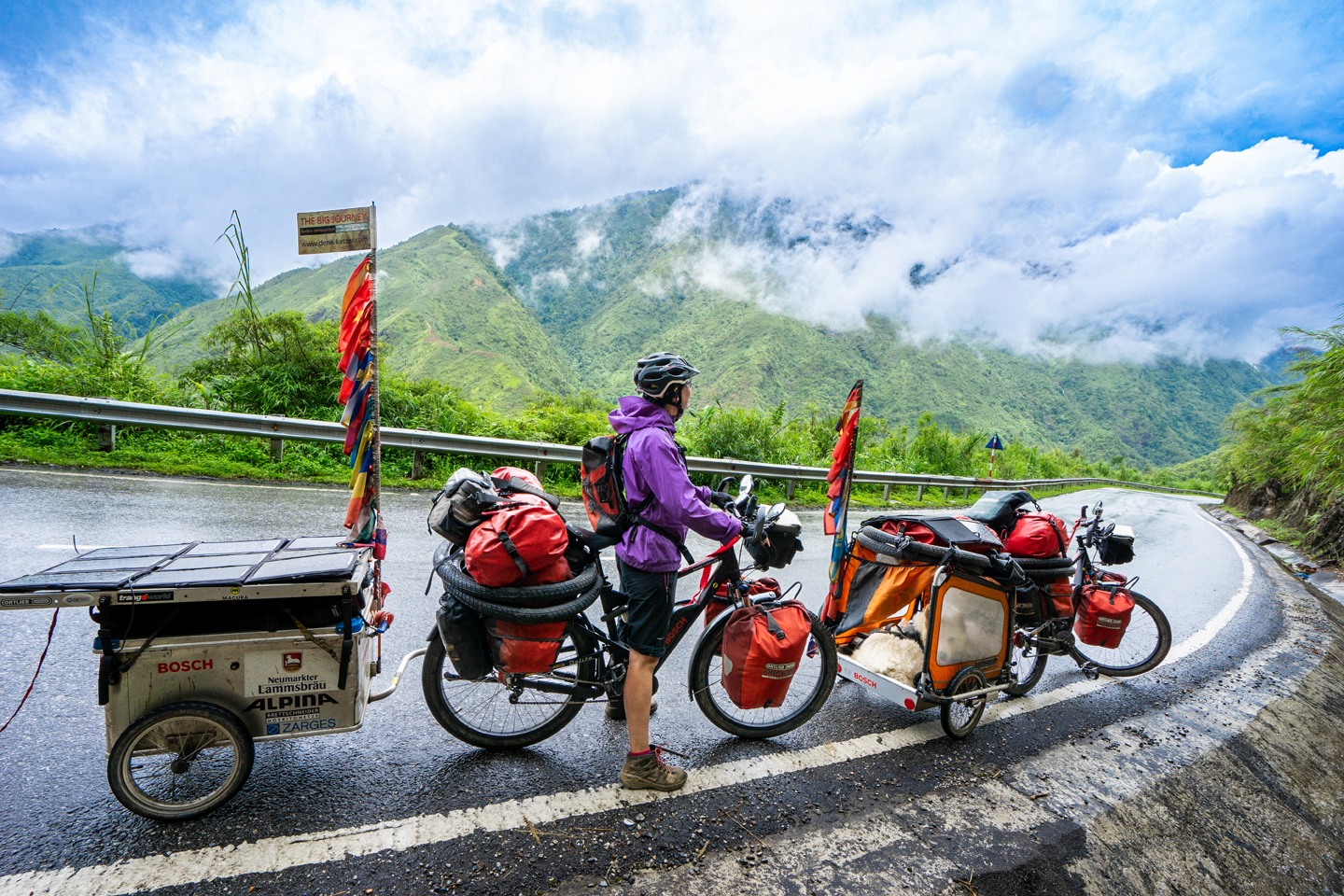
At the fang cape
N 53°17'21.8'' E 107°35'38.6''
Day: 58
Sunrise:
06:22 am
Sunset:
9:26 pm
As the crow flies:
34 Km
Daily kilometers:
39.10 Km
Total kilometers:
12421.79 Km
Soil condition:
Sand / clay
Temperature – Day (maximum):
31 °C
Temperature – day (minimum):
21 °C
Temperature – Night:
8 °C
Latitude:
53°17’21.8”
Longitude:
107°35’38.6”
Maximum height:
690 m above sea level
Maximum depth:
460 m above sea level
Time of departure:
12.10 p.m.
Arrival time:
7.10 p.m.
Average speed:
9.1 Km/h
“Thought we had the worst behind us?” Tanja puffs her loaded bike up the incline meter by meter. For several kilometers, the trail mainly leads over root networks and washed-out holes through a forest. In some places it is so steep that we only manage to push the bikes over the obstacles with our combined strength. “That doesn’t make any sense,” Tanja grumbles. “If you want, we can turn back,” I offer her, although I personally would love to reach the end of the island. “No, I’m not giving up so close to the finish line,” she replies and pushes her aluminum frame on wheels further over the grotty surface. A broken axle on the side of the road shows how difficult it is for four-wheel drive vehicles here. Today, too, we hope that our riese und müller will not give up. They are designed for extreme conditions, but everything has its limits. Because we’ll soon be bumping incessantly over washboard floors, we’re delighted with the Magura shock absorber. Even though Magura is one of our sponsors and we would like to speak well of our partners, I can write at this point that it is not difficult for us to praise this marvel of technology in the highest terms. In fact, the rear wheel is so well sprung that we hardly feel the terrible bumps. They are almost completely absorbed. The raw open hub also proves itself indescribably well under such conditions. Shifting under massive pressure, and doing so incessantly, does not cause the hub and its functionality the slightest difficulty. The chain still rattles unpleasantly over the sprockets. But this is completely irrelevant for the closed gearshift system. It works in, over and on the sand and mud. Simply fantastic.
We reach the end of the forest and thus also the highest point of the slope. Just like yesterday, we are back on the hilly mountain steppe. The wide view up here is liberating. The sand mountains are now behind us and we are able to cycle again. At perhaps 30 degrees in the shade, a pleasantly cool wind blows up to us from Baikal. The coast looks rugged and impressive. Rocks stand out from the cliffs and jut their bizarre edges into the blue sky. Although we were repeatedly told on this trip that it can already be foggy and cold in August, the weather here belies this statement. “It’s going to rain tomorrow. The roads will be slippery and almost impassable,” a driver warned us yesterday. We don’t want to throw caution to the wind, because when these clay tracks get wet, progress is certainly impossible. So we hurry to reach Cape Choboi, the northern tip of Alchon, soon and return today.
In the afternoon we cycle our bikes over one last steppe hill. Excited with joy, we let ourselves roll down the other side to the two rocks of Cape Choboi. “We have made it! Yay! Yay!”, we shout and in moments like this we know why we have put in the effort over the past few days. Impressed, we stand there and gaze at the blue of the Baikal, which stretches as far as the horizon. The towering cliff of Cape Choboi, which incidentally is a Buryat word meaning “fang”, is separated in the middle by a broad, grass-covered ridge. People use this path to climb to the top of the cliffs to look out over the waves of the Baikal. According to what we have heard, with a lot of luck you can observe the most famous endemic animals, the Baikal seal, from the cliff. Together with the Canadian Seal Lake seals, they are the only freshwater seals in the world. However, because of the many tourists here at the Cape, they rarely sunbathe on the rocks. Their most popular, thankfully strictly protected moorings are located on the Ushkani Islands not far from the Holy Nose peninsula. It is assumed that the Baikal seals must have migrated via the Jennisei and Angara rivers during the last ice age. After the subsequent retreat of the sea, due to changing climatic conditions, they became isolated in the lake. The current distance to the sea is around 1,700 kilometers. The Nerpa, as it is called in Russian, was hunted by the indigenous people and later also by the Russians. Today, only a few Ewenken settlements on the North Baikal are allowed to hunt the fascinating animals with their black googly eyes in very limited numbers. The fatty meat makes up part of their diet. They use the fur to make coverings for their snowshoes, hats, boots and jackets. Today, the population of nerpas is estimated at 80-100,000 animals.
Spellbound by the fascinating sight, we gaze for a long time at the inland water, whose catchment area with its tributaries covers around 1.5 million km². “If you imagine that this area is four times the size of Germany,” I say quietly. A strong northerly wind blows against us, making our stay here quite uncomfortable. We leave the Fang Cape behind us and take advantage of the current tailwind and the good weather to start our return journey. Just 2 ½ hours later, shortly after 7 p.m., we arrive back at our sublime camp by the larches above the Baikal. It doesn’t take long and we are warmed by a burning, huge tree stump that I have torn from the earth of the former labor camp.

